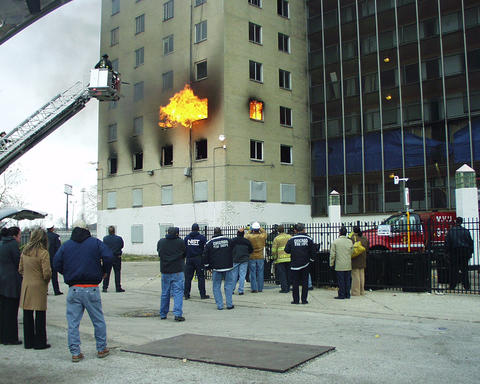
Members of a research team watch flames erupt from an abandoned Chicago apartment building during a November 10, 2006, test of positive pressure ventilation in high-rise fires. Red truck (lower right corner) is a mobile ventilation system blowing air through the front door of the test building to keep the corridors and stairwells passable, while forcing the fire outside.
The blow-torch-like flames erupting from the windows of an abandoned, 16-story Chicago apartment building on Nov. 10 were certainly dramatic to watch from the street below. However, for a team of investigators from the Chicago Fire Department (CFD), the Chicago Housing Authority (CHA) and the National Institute of Standards and Technology (NIST), the real excitement was what was happening to the environment inside the building's corridors and stairwells.
The controlled fires on the third, 10th and 15th floors of the Windy City high-rise were part of a real-world laboratory experiment to study the effectiveness in multistory buildings of positive pressure ventilation (PPV). PPV is the use of powerful fans during fires to force smoke and heat from corridors and stairwells so that they stay passable and safe for both escaping occupants and entering emergency responders. In past events—such as the October 2003 blaze in a government building in Chicago where six people died—fire flow into corridors and stairwells often has resulted in tragedy.
Eleven NIST researchers worked with more than 70 CFD and CHA staff for the two weeks prior to the experiment to prepare the building. All 16 floors were equipped with temperature and pressure monitors while the three burn floors also included cameras, heat flux gauges and typical apartment furnishings. The entire setup was connected to the data acquisition center by seven miles of cable.
Once the fires were under way, a variety of ventilation tests were conducted. For example, in one test, a large fan was placed at the front door to force cool air up through the building. In another test, two smaller fans—one on the first floor and one two floors below the fire floor, both forcing air into the stairwell—were used to achieve the same PPV effect. Preliminary results from both scenarios show that PPV significantly reduced the temperature and amount of smoke in the corridors and stairwells outside the burn rooms. In one case, the temperature quickly dropped from 316 degrees Celsius to 16 degrees (600 degrees Fahrenheit to 60).
A NIST report on the tests is expected to be released in the spring of 2007.
Three major fan manufacturers and fire departments from New York City; Delaware County, Pa.; Toledo, Ohio; and Ottawa, Canada, also participated in the exercise. Underwriters Laboratories personnel used the setting to assess smoke detector activation in high-rise fires. The experiment was sponsored in part by the U.S. Department of Homeland Security.

